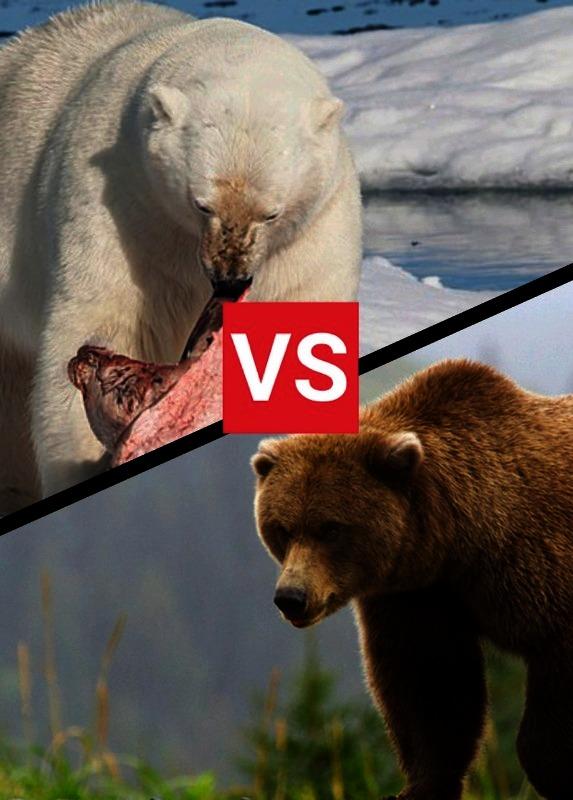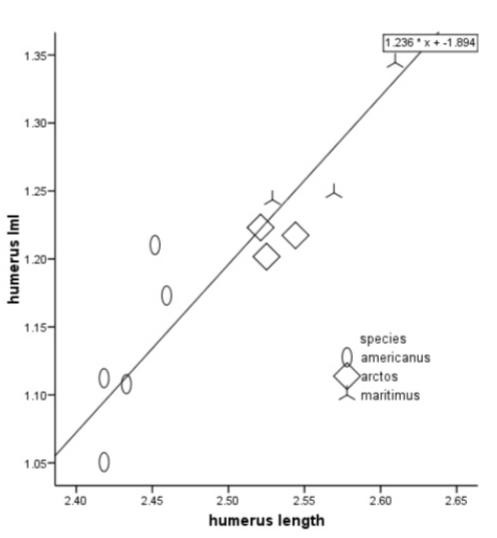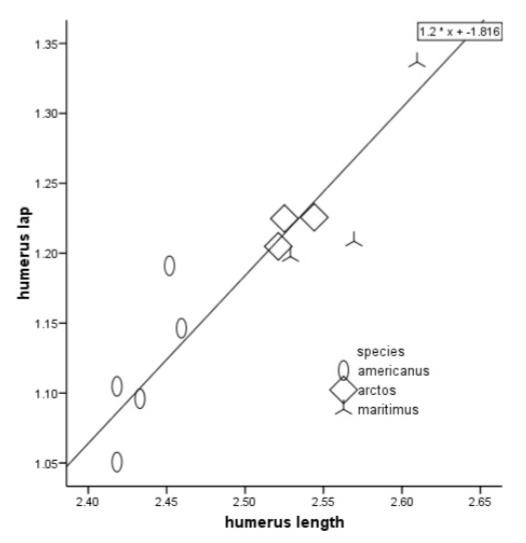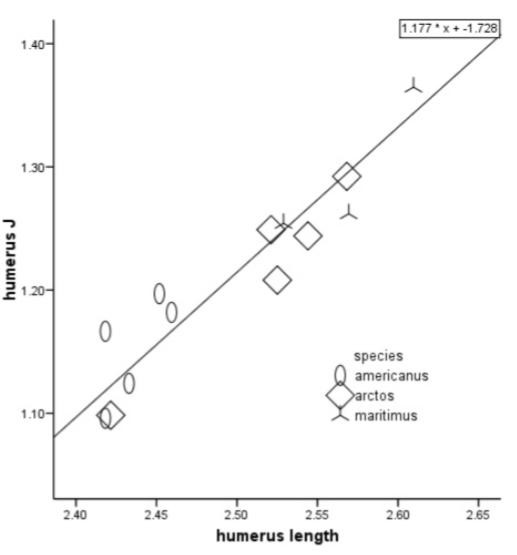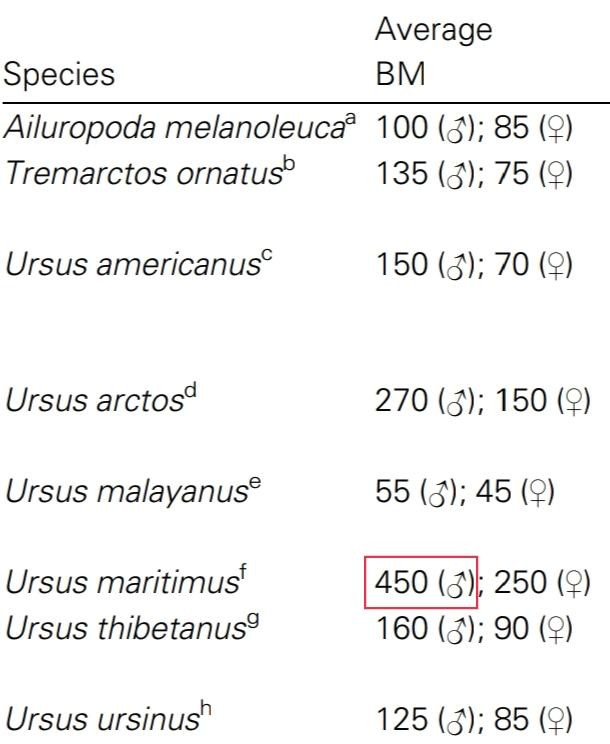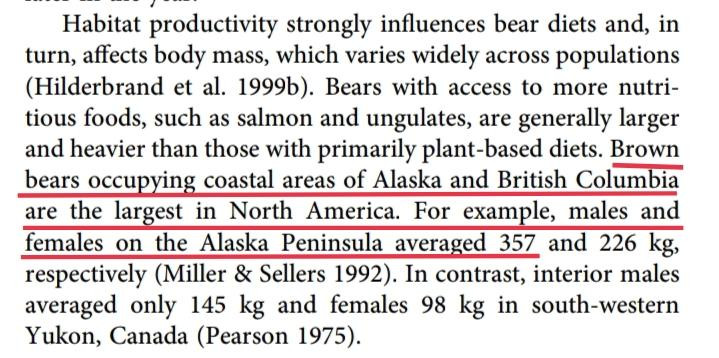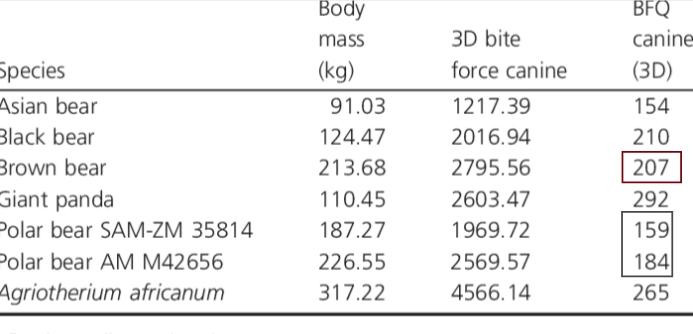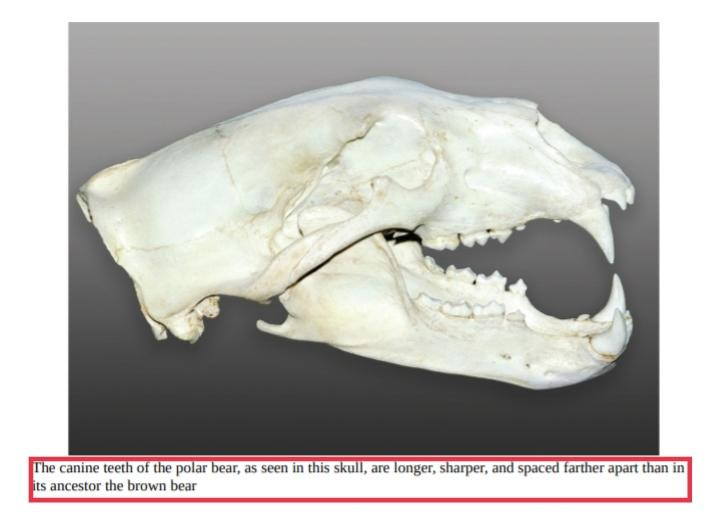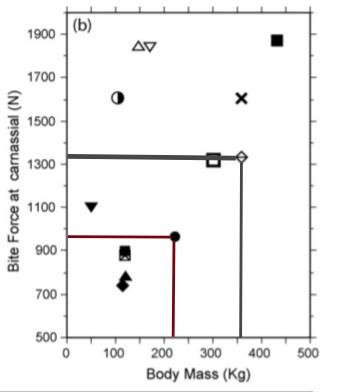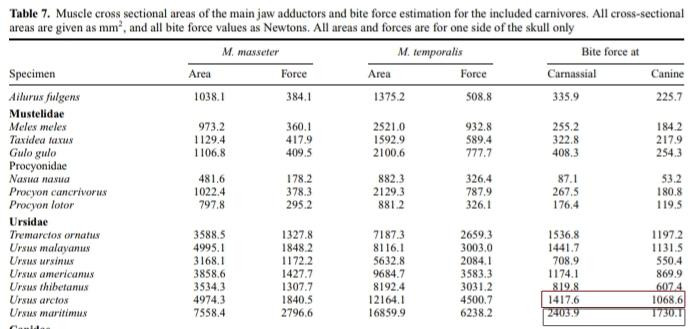Shoulder Hump:
The large dorsal hump distinguishes brown bears from other species. The hump contains muscles that add strength and power to the forelimbs.
U.Maritimus : Absent
U.Arctos : Present
Edge : U.Arctos
Scapula Shape Index:
It's scapula width/forelimb length ratio.Higher score indicates greater muscle attachement on the shoulder joint as well as greater ability to make certain movements like full-functional upper extremity movement including protraction,retraction,elevation,depression,upward rotation,and downward rotation all else being equal.
U.Maritimus : 26%
U.Arctos : 26%
Edge : Draw
Scapula Length Index:
Scapula length divided by Forelimb length. Higher score Indicates exertion of greater force from the Forelimb.
U.Maritimus : 29%
U.Arctos : 30%
Edge : U.Arctos
API:
Acromion process length/forelimb length. Higher score in this ratio increases attachment for the deltoid muscle.
U.Maritimus : 6%
U.Arctos: 6%
Edge : Draw
SMI:
Deltopectoral crest length divided by humerus length. Higher score Displays greater mechanical advantage of deltoid and pectoral muscles at the shoulder joint and provides a larger inlever and thus
greater inforce.
U.Maritimus : 69%
U.Arctos : 72%
Edge : U.Arctos
HRI:
It is humerus mediolateral diameter at mid-shaft/humerus length.Robust forelimb bones protect the animal from violent stresses during grappling and increase muscle mass.
U.Maritimus : 10%
U.Arctos : 11%
Edge : U.Arctos
HRI2:
It is humerus anteroposterior diameter at mid-shaft/humerus length. Robust forelimb bones protect the animal from violent stresses during grappling and increase muscle mass.
U.Maritimus : 12%
U.Arctos : 12%
Edge : Draw
HCMI:
It is Humeral circumference/articular length Often-used variable in analyses of bone strengths in locomotion. The higher the ratio is, the thicker the Humeral bone is.
U.Maritimus : 32%
U.Arctos : 34%
Edge : U.Arctos
Lml/Length:
This measure is used to estimate aspects of long Humeral midshaft bone strength in bending about mediolateral plane.
U.Maritimus : exact value unknown
U.Arctos : exact value unknown
Edge : U.Maritimus
Lap/Length:
This measure is used to estimate aspects of long Humeral midshaft bone strength in bending about anteroposterior plane.
U.Maritimus : exact value unknown
U.Arctos : exact value unknown
Edge : Draw
J/Length:
This measure is used to estimate aspects of long Humeral midshaft bone strength in average rigidity in non-axial loading.
U.Maritimus : exact value unknown
U.Arctos : exact value unknown
Edge : U.Maritimus
HEI:
The HEI index measures the relative size of wrist stabilizing muscles and well as several grasping muscles in area which facilitate prey grasping. These muscles also likely help stability, pushing, and agility when legs are on ground.
U.Maritimus : 32%
U.Arctos : 30%
Edge : U.Maritimus
PC2:
Scoring intermediate or low on PC2 are carnivorans that use their forelimbs to subdue,manipulate or excavate food items.Carnivorans scoring low on PC2, i.e. grapplers like felids, have relatively shallow trochlear furrows and relatively large and distally-projecting medial trochlear flanges. These features provide extra stability against forces acting in a nonparasagittal plane.
U.Maritimus : -7,999
U.Arctos : -7,045
Edge : U.Maritimus
HTI:
It's Humeral trochlear length/Humeral length. Higher score increases muscle attachement on the elbow joint and allows for more ulnohumeral flexion and extension.
U.Maritimus : 22%
U.Arctos : 21%
Edge : U.Maritimus
HCI:
This is a measure of the humerus joint surface size near elbow. Higher scores indicate greater forearm mobility and stability during grappling and also likely when feet are on ground during a struggle as well as an increased ability to better distribute large loads.
U.Maritimus : 22%
U.Arctos : 20%
Edge : U.Maritimus
Brachial index:
This measures radius length/humerus length. Lower scores in this ratio indicate greater forelimb muscle mechanical advantage and results in stronger muscles all else being equal.
U.Maritimus : 81%
U.Arctos : 86%
Edge : U.Maritimus
Brachial index 2:
This measures ulna length/humerus length. Lower scores in this ratio indicate greater forelimb muscle mechanical advantage and results in stronger muscles all else being equal.
U.Maritimus : 101%
U.Arctos : 96%
Edge : U.Arctos
Forelimb Proportion Index:
Length of proximal forelimb relative to length of distal forelimb ((Scapula length + Humerus length)/(Radius length + Metacarpal length)). Higher score Indicates greater degree of morphological specialization for producing large out-forces in the forelimb.
U.Maritimus : 149%
U.Arctos : 154%
Edge : U.Arctos
RRI:
This measures radius mediolateral diameter at midshaft divided by radius length. As mentioned above for humerus robusticity, a robust radius resists stresses on bones during fights and increases resistance to bites to the forelimb and increases muscle mass.
U.Maritimus : 11%
U.Arctos : 11%
Edge : Draw
RRI2:
This measures radius anteroposterior diameter at midshaft divided by radius length. As mentioned above for humerus robusticity, a robust radius resists stresses on bones during fights and increases resistance to bites to the forelimb and increases muscle mass.
U.Maritimus : 6%
U.Arctos : 6%
Edge : Draw
OI:
This metrics estimates tricep muscle strength. High values indicate greater ability to push with arms all else being equal. This helps a grappling cat hold prey and also helps a canid push and knock down an opponent. In addition, higher values may indicate greater stability and ability to change direction in a fight as well as greater relative mechanical advantage of the triceps brachii and dorsoepitrochlearis muscles used in elbow extension.
U.Maritimus : 20%
U.Arctos : 20%
Edge : Draw
URI:
It is ulna mediolateral diameter at mid-shaft/humerus length. As mentioned above for humerus and radius robusticity, Robust forelimb bones protect the animal from violent stresses during grappling and increase muscle mass.
U.Maritimus : 6%
U.Arctos : 6%
Edge : Draw
URI2:
This measures ulna anteroposterior diameter at midshaft divided by ulna length. As mentioned above for humerus and radius robusticity, a robust ulna resists stresses on bones during fights and increases resistance to bites to the forelimb and increases muscle mass.
U.Maritimus : 12%
U.Arctos : 10%
Edge : U.Maritimus
MANUS:
Manus digit 3 proximal phalanx length divided by metacarpal 3 length.Higher score Indicates greater relative proportions of proximal and distal elements of the manus and size of the palmar surface.
U.Maritimus : 49%
U.Arctos: 55%
Edge : U.Arctos
CLAW:
Manus digit three terminal phalanx length divided by pes digit three terminal phalanx. Higher score is to be expected in species whose claws are more capable of breaking soil.
U.Maritimus : 100%
U.Arctos : 136%
Edge : U.Arctos
Studies Used For The Above Comparison :
https://www.researchgate.net/publication/277429034_Ursus_maritimus
https://dukespace.lib.duke.edu/dspace/handle/10161/1602
Throughout the centuries, the Lion has been popularly known as the King Of All Terrestrial Predatory Animals. While certainly impressive enough in its own right, modern research has demonstrated that Bears tend to be more powerfully built than Big Cats including Lions even on a proportional basis. The Polar and Brown Bears are the biggest and strongest extant representatives of the Bear family and therefore both deserve the title more than Lions do. Yet, only one can get the number 1 spot. In terms of size, the Polar Bear seems to be the likely candidate since with a body mass of 450 kg , it's on average bigger than even the largest Brown Bear populations which weigh around 360 kg :
https://zslpublications.onlinelibrary.wiley.com/doi/abs/10.1111/j.1469-7998.2006.00286.x
https://pubs.er.usgs.gov/publication/70217182
However, if we want to compare the two on a pound per pound basis, both Bears have similarly thick, scapulae Humeri, radii and long acromion processes and olecrana.However,Ursus Maritimus has wider epicondyles,trochleas, condyles,shorter radii and thicker ulnae while Ursus Arctos has a shoulder Hump,relatively larger scapulae, deltopectoral crests,shorter ulnae,more enlarged metacarpals, deadlier claws and the ability to produce more force as evident from its Forelimb Proportions.Each Bear has its own advantages in this matchup but Brown Bears are likely overall stronger relatively speaking due to their stronger joints, wider areas of attachment for major sacrococcygeal muscles, better vertebral column stabilisation and more developed areas of attachment for the longissimus muscle (positive PC1 score) :
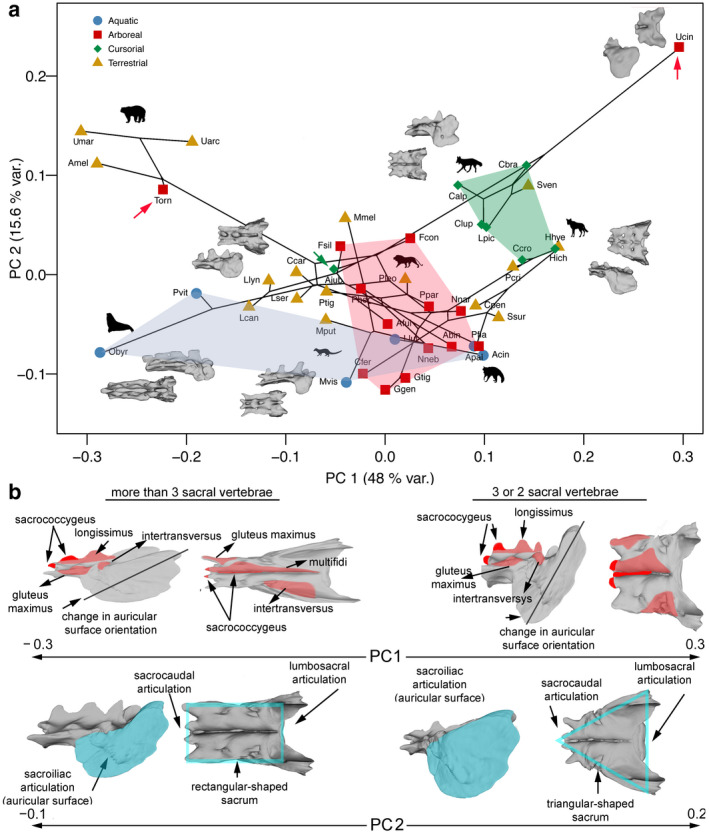
They also bite harder than Polar Bears of equal size as evident from their respective BFQ scores :
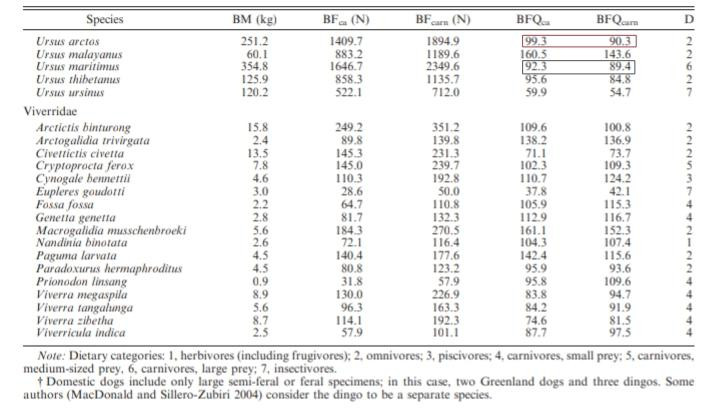
https://pubmed.ncbi.nlm.nih.gov/17479753/
And have mostly dominated Polar Bears weighing twice as much during interspecific competition for carcasses :
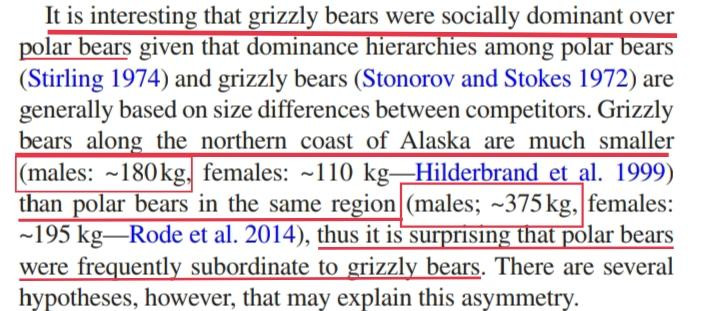
https://academic.oup.com/jmammal/article/96/6/1317/1174934
This is despite the fact that the Polar Bear has longer,sharper canine teeth :
https://www.press.jhu.edu/books/title/12119/bears-north
And that it's decent size advantage would evidently not only allow it to be significantly more powerfully built but deliver a more forceful bite as well :
https://pubmed.ncbi.nlm.nih.gov/17479753/
https://zslpublications.onlinelibrary.wiley.com/doi/abs/10.1111/j.1469-7998.2006.00286.x
Therefore, Ursus Arctos rightfully earns the title of King of All Terrestrial Predators while Ursus Maritimus gets the second place !

